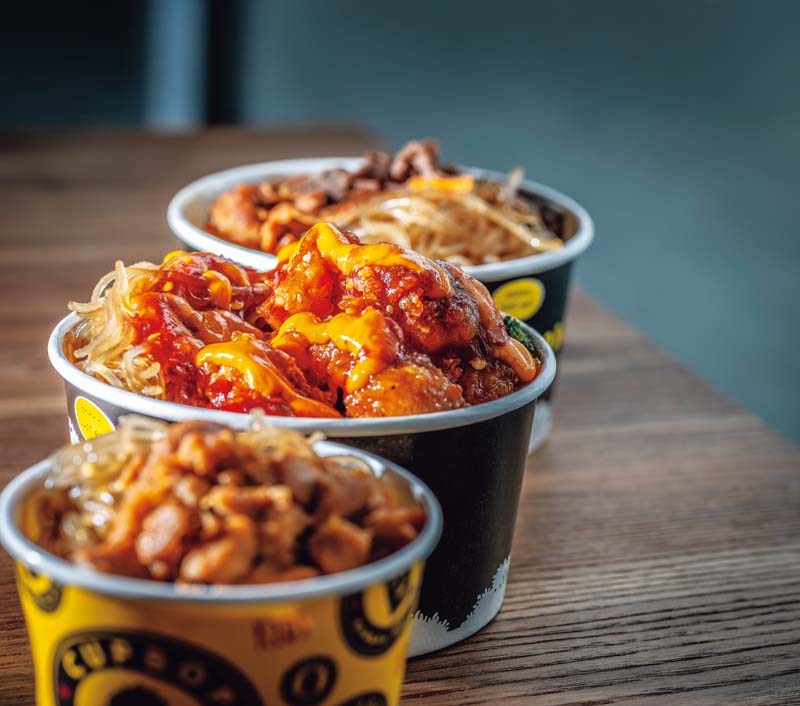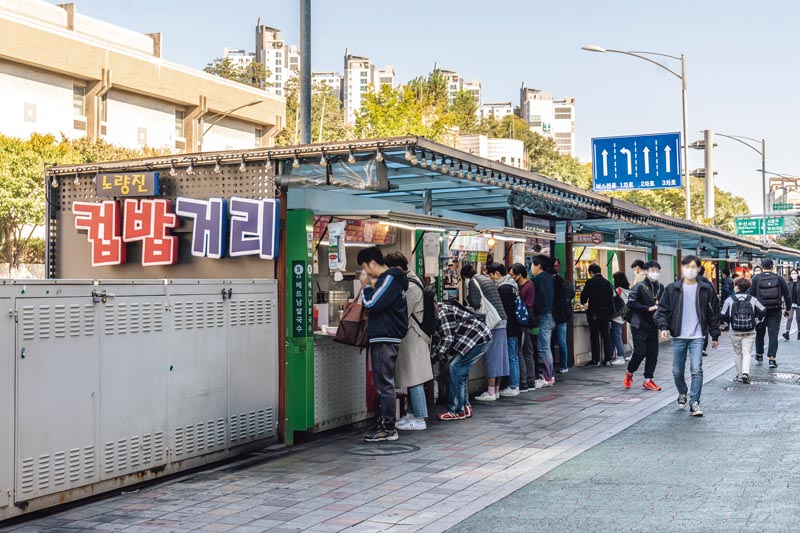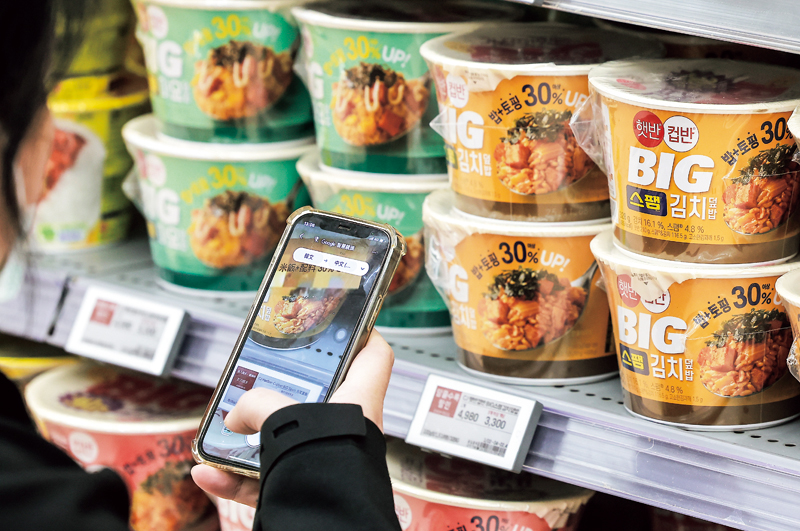In the early 2010s, as the cost of living soared, a quiet revolution unfolded at the street food stalls of Noryangjin, Seoul. In this neighborhood, cupbap — “rice in a cup” — was born, a meal that was fast, filling, and easy on the wallet. Emerging from the needs of its time, this simple dish evolved into a cultural icon. What began as simple survival food for hungry students has become a marker of Korea’s street food culture.

Founded by Junghun Song in 2013, Cupbop began as a single food truck in Utah and has since grown into a global brand with locations across the United States. The company’s success lies in its adaptation of Korean recipes to American tastes and culture.
© Cupbop
The expression “10,000-won lunch era” began circulating in 2011, as rising food costs dominated the headlines: 9,500 won for a bowl of kongguksu (noodles served cold in creamy soy milk), 8,000 won for a bowl of kalguksu (hand-cut wheat noodles served in a warm broth), 10,000 won for a bowl of seolleongtang (ox bone soup). To cut back on lunch expenses, workers began flocking to staff cafeterias inside government buildings, universities, and office towers, while convenience store lunch boxes started flying off the shelves. But this trend wasn’t only about saving money on food — it signaled a deeper shift in Korean society toward survival-driven consumption.
Economically, 2011 was particularly difficult for Korea. Productivity in manufacturing and large enterprises slowed down, and the country’s economic growth rate dipped below the global average. The producer price index rose by 6.7 percent over the previous year, while the consumer price index climbed 4 percent, marking the end of Korea’s high-growth era and the onset of low growth. The persistent rise in prices brought growing uncertainty about the future.
While office workers were forced to reconsider their lunch options, two demographics faced an even harsher reality: recent graduates seeking employment and gosisaeng (civil service exam candidates). Relying on financial support from their parents, the latter had to devote all their time to studying. This meant part-time jobs were a luxury few could afford, and even meals had to be approached with efficiency in mind.
NORYANGJIN NATIVE
Noryangjin is a Seoul neighborhood known for its large concentration of hagwon, or private academies. In the 1980s and 1990s, it rose to prominence as a hub for academies that prepped students to take the national university entrance exam. However, as many of these hagwon gradually relocated to the Gangnam area, Noryangjin became dominated by establishments offering preparation for the civil service exams. Today, it remains one of Korea’s best-known gosichon, a place attracting would-be civil servants from across the country.
Among the neighborhood’s standout features are the gosi sikdang, buffet-style restaurants that offer unlimited rice and side dishes for a set price. Prices today are as low as 7,000 won, but back in 2011, when the average lunch exceeded 10,000 won, gosi sikdang meals hovered even lower, at around just 3,000 won. Unfortunately, even this price was still a burden for many exam candidates. Yet as the cost of living continued to rise, these restaurants were forced to raise their prices, adding to students’ worries.
Another familiar sight in Noryangjin was the long line of food stalls stretching along the street across from the subway station. They mainly sold snack foods such as tteokbokki (stir-fried rice cakes in spicy sauce), corn dogs, and hamburgers, but some also offered jumeokbap (fist-sized rice balls) or simple deopbap (rice with various toppings). In 2011, food stalls focusing on rice-based dishes began to proliferate, offering fried rice and deopbap with a wider variety of toppings. These were sold for around 2,000 won and served in plastic, Styrofoam, or paper containers, thus marking the birth of cupbap.
Considering that 3,000 won was enough for a buffet-style meal at a gosi sikdang, 2,000 won for cupbap may not seem like a bargain. Yet for exam candidates on a tight budget, that 1,000 won difference was hardly trivial. Moreover, while the buffets were inexpensive, the quality of the food often left much to be desired, and many students preferred not to spend valuable time navigating them. Cupbap, by comparison, was fast, filling, and packed with sweet and savory flavors that appealed to younger palates. And with no need to wait in line, students could finish eating in five minutes and quickly return to their studies. Cupbap checked all the boxes in terms of affordability, taste, and convenience.

Cupbap Street in Noryangjin, home to the food stalls that gave birth to the dish in the early 2010s as an affordable option for civil service exam candidates on tight budgets.
© Seoul Tourism Organization
DECLINE OF CUPBAP STREET
A portmanteau of “cup” and “bap” (cooked rice), the term “cupbap” — inspired by cup ramyeon (instant noodles in disposable cups) — was quickly embraced by the media. The emergence of a new food culture created by civil service exam hopefuls was a compelling narrative. In an era of 10,000-won lunches, cupbap’s much lower price tag also had symbolic significance. More than just a cheap meal, it came to represent the younger generation’s approach to coping with rising living costs.
However, as the cupbap craze gained momentum, certain problems began to arise. Nearby restaurants complained that the food stalls were hurting their sales, leading municipal authorities to step in with regulatory crackdowns. Cupbap vendors were forced to either switch to selling foods other than rice-based dishes — like ramyeon and hot bars (fish cake skewers) — or sidestep restrictions by using foil trays instead of disposable cups.
Ironically, as the original cupbap vendors were being pushed out of Noryangjin, the trend they had started was spreading rapidly throughout the country. New variations emerged, such as vegan cupbap and keto cupbap, to appeal to more health-conscious consumers. In 2012, a convenience store chain quickly capitalized on the trend and released its own cupbap products. But by then, Noryangjin food stalls had already stopped selling the dish due to crackdown pressures. “So it’s okay for big corporations to profit, but not ordinary citizens?” stall owners protested — an indication of the social inequalities underlying the cupbap craze.
Three years later, after mediation with the district office, the cupbap stalls were relocated about 150 meters away from the original hagwon district to nearby Sayuksin Historical Park. However, the appeal of the newly established Cupbap Street quickly declined. As young Koreans began to find civil service jobs less attractive, the number of gosisaeng dwindled, and the atmosphere of the neighborhood changed accordingly. But although its heyday has passed, Noryangjin cupbap continues to draw interest — Cupbap Street has now become a tourist attraction, drawing more families and young couples than students. In this way, cupbap has evolved from a culinary creation symbolizing the survival spirit of Korean youth into a new form of consumer culture.
Interestingly, business boomed for street vendors the moment they started selling rice-based dishes instead of typical Korean snack foods. As the popular saying goes, “for Koreans, rice is the fuel of life.” It’s no surprise, then, that exam candidates favored rice over tteokbokki or noodles to recharge their batteries. Food made with processed wheat flour causes blood sugar to spike quickly only to crash soon after, leaving one hungry again. Rice, on the other hand, is digested more slowly and provides lasting satiety. Millennia of daily rice consumption have wired the human body to know this instinctively.
A GENERATIONAL TREND
Today, cupbap continues to evolve, with more sophisticated menu offerings, branded products, and its resurgence as a global K-food icon. Its rapid success mirrors that of ramyeon, and with the development of frozen and ready-to-heat versions, it has become a staple of convenience stores and supermarkets. The idea of a quick and simple meal that can be enjoyed at home anytime has aligned with the times, helping to further solidify cupbap’s mainstream appeal.
Cupbap is now going global. A prime example is Cupbop, an American franchise with roots in Utah. It was founded by Junghun Song, a former B-boy who went to the U.S. as an international student. By reimagining cupbap in the style of American fast food — serving rice, meat, sauce, and various toppings in a single bowl — Song tapped into the tastes of the local market. The secret to the brand’s success lies in preserving Korean flavors while presenting them in a way that appeals to Western palates. Established over twenty years ago, Cupbop continues to expand across the U.S., riding the wave of growing interest in Korean cuisine. Beyond the U.S., cupbap is also becoming synonymous with Korean snack food in places like Japan, Southeast Asia, and parts of Europe. Joining the ranks of BTS, kimchi, and bulgogi as a Korean Wave cultural export, cupbap has penetrated the daily lives of many people around the world.
Cupbap is about more than just convenience — it mirrors changes in Korean society while serving as a window into the evolving lifestyles of the younger generation. From its humble street food beginnings, cupbap has now spread worldwide, offering a delicious glimpse into Korean culture and lifestyle.

Noryangjin’s cupbap has also made its mark on the ready-to-eat foods market. With the rise in single-person households and demand for convenient meals, various types of cupbap are now available at convenience stores and supermarkets.
© NewsBank